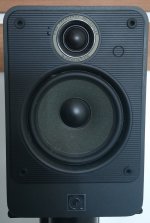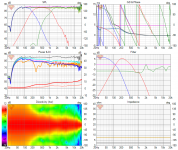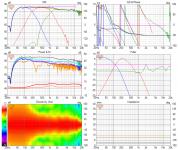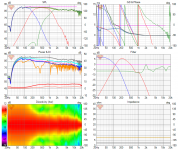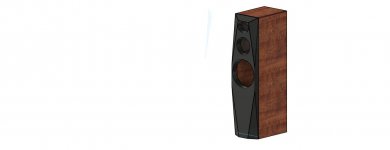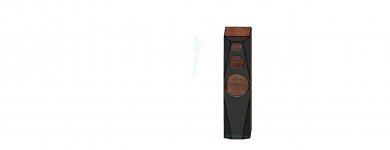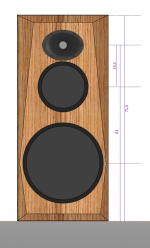Awesome... I will try to buy sufficient quantity of this adhesive then. Since i dont have the means to make the speaker boxes myself, i will ask friends who can do it for me to consider the suggestions you gave regarding how to apply the glue etc..
I will now try to make a 3D drawing of the cabinet and in the process, try to learn some aspects of Fusion 360 also.
Thanks a lot for your studies in general, I will keep on reading it and try to use the constuction methods you suggest to the maximum possible extent in this project..
Thanks
Vineeth
I will now try to make a 3D drawing of the cabinet and in the process, try to learn some aspects of Fusion 360 also.
Thanks a lot for your studies in general, I will keep on reading it and try to use the constuction methods you suggest to the maximum possible extent in this project..
Thanks
Vineeth
Out of the blue a test popped up into my mind one can test whether the increased c-c main benefit, smoother ER from ceiling / floor, is more benefitical than size of lobe is to put the speaker sideways 😀
If you have speakers that have the c-c spacing as close as possible, for the counter argument having big main lobe is more important than ER, then the test would show which one is more important, the lobe or vertical ER? The caveat is that the horizontal ER would also change when the speaker is sideways. If the listening setup is put middle of biggish room so that distance to walls is greater than to the ceiling this should work I think, at least give some indication?
I read a text late last night, I think it was some article by amirm in the ASR forum, which wrote about the audibilit of ER generated comb filtering. The text wrote something like the comb filtering is not very audible in high frequencies due to how hearing works (hearing resolution for high Q wiggle is poorer on the high frequencies). Also wrote that horizontal ER generated comb filtering is different at both ears since the direct sound is almost the same but the ER coming more from one side of the will make different shaped comb filter due to ILD and ITD, and the the brain has change to average it out because the difference for both ears.
The text didn't mention ER from the ceiling and floor (unless I fell asleep momentarily) but reasoning from this I would guess comb filtering due to ceiling / floor reflection is more similar for both ears because ILD and ITD is same for both direct and reflected sound and thus would be slightly more audible than reflections in horizontal plane, especially when the frequencies get lower and ear resolution increases. Anyway, reasoning from this the vertical ER would be more noticeable than horizontal if brain can't cancel it out as good and thus there is possibility that improving the vertical ER would yield better sound experience. But of course we should be sure some other aspect getting worse (main lobe for example) doesn't negate the improvement.
A bit off topic but kind of related to the previous discussion so thought to write it here.
ILD = Interaural level difference
ITD = Interaural time difference
ps. I'm sure there is literacy over all this. Should read some...
If you have speakers that have the c-c spacing as close as possible, for the counter argument having big main lobe is more important than ER, then the test would show which one is more important, the lobe or vertical ER? The caveat is that the horizontal ER would also change when the speaker is sideways. If the listening setup is put middle of biggish room so that distance to walls is greater than to the ceiling this should work I think, at least give some indication?
I read a text late last night, I think it was some article by amirm in the ASR forum, which wrote about the audibilit of ER generated comb filtering. The text wrote something like the comb filtering is not very audible in high frequencies due to how hearing works (hearing resolution for high Q wiggle is poorer on the high frequencies). Also wrote that horizontal ER generated comb filtering is different at both ears since the direct sound is almost the same but the ER coming more from one side of the will make different shaped comb filter due to ILD and ITD, and the the brain has change to average it out because the difference for both ears.
The text didn't mention ER from the ceiling and floor (unless I fell asleep momentarily) but reasoning from this I would guess comb filtering due to ceiling / floor reflection is more similar for both ears because ILD and ITD is same for both direct and reflected sound and thus would be slightly more audible than reflections in horizontal plane, especially when the frequencies get lower and ear resolution increases. Anyway, reasoning from this the vertical ER would be more noticeable than horizontal if brain can't cancel it out as good and thus there is possibility that improving the vertical ER would yield better sound experience. But of course we should be sure some other aspect getting worse (main lobe for example) doesn't negate the improvement.
A bit off topic but kind of related to the previous discussion so thought to write it here.
ILD = Interaural level difference
ITD = Interaural time difference
ps. I'm sure there is literacy over all this. Should read some...
Last edited:
The reason I'm still thinking about this is that the c-c rule should work out better with higher xo frequencies. I mean the comments of augerpro and others said close c-c was perceived better. If c-c was to be increased, better keep the increase small, right?
If crossover was at ~1kHz, then a 1.2 wl c-c would be roughly 40cm, quite mucho 😀 With few meter listening distance the distance of both transducers to the ear would change much when moving around because the c-c is proportionally big to the listening distance. The sound would be quite sensitive to listening position.
On the other hand, if the xo was at ~3000Hz, the 1.2wl c-c was only ~13cm. Much smaller proportionally to the few meter listening distance. In this case the direct sound should be much less sensitive to listening position variance.
Anyway, just looking at it from various perspectives. I haven't done listening tests yet.
If crossover was at ~1kHz, then a 1.2 wl c-c would be roughly 40cm, quite mucho 😀 With few meter listening distance the distance of both transducers to the ear would change much when moving around because the c-c is proportionally big to the listening distance. The sound would be quite sensitive to listening position.
On the other hand, if the xo was at ~3000Hz, the 1.2wl c-c was only ~13cm. Much smaller proportionally to the few meter listening distance. In this case the direct sound should be much less sensitive to listening position variance.
Anyway, just looking at it from various perspectives. I haven't done listening tests yet.
Last edited:
I think you are right about higher crossover frequencies and the 1.2x c-c rule being more relevant. Somewhere in the threads that you had pointed out earlier, I think I read Kimmosto mentioning something like tweeter-mid crossovers above 2.5 kHz to avoid ear bleeding sound etc.. 😀
Out of the blue a test popped up into my mind one can test whether the increased c-c main benefit, smoother ER from ceiling / floor, is more benefitical than size of lobe is to put the speaker sideways 😀
If you have speakers that have the c-c spacing as close as possible, for the counter argument having big main lobe is more important than ER, then the test would show which one is more important, the lobe or vertical ER? The caveat is that the horizontal ER would also change when the speaker is sideways. If the listening setup is put middle of biggish room so that distance to walls is greater than to the ceiling this should work I think, at least give some indication?
I read a text late last night, I think it was some article by amirm in the ASR forum, which wrote about the audibilit of ER generated comb filtering. The text wrote something like the comb filtering is not very audible in high frequencies due to how hearing works (hearing resolution for high Q wiggle is poorer on the high frequencies). Also wrote that horizontal ER generated comb filtering is different at both ears since the direct sound is almost the same but the ER coming more from one side of the will make different shaped comb filter due to ILD and ITD, and the the brain has change to average it out because the difference for both ears.
The text didn't mention ER from the ceiling and floor (unless I fell asleep momentarily) but reasoning from this I would guess comb filtering due to ceiling / floor reflection is more similar for both ears because ILD and ITD is same for both direct and reflected sound and thus would be slightly more audible than reflections in horizontal plane, especially when the frequencies get lower and ear resolution increases. Anyway, reasoning from this the vertical ER would be more noticeable than horizontal if brain can't cancel it out as good and thus there is possibility that improving the vertical ER would yield better sound experience. But of course we should be sure some other aspect getting worse (main lobe for example) doesn't negate the improvement.
A bit off topic but kind of related to the previous discussion so thought to write it here.
ILD = Interaural level difference
ITD = Interaural time difference
ps. I'm sure there is literacy over all this. Should read some...
Hi,
I have a pair of Qacoustics 2020i 2 way bookshelf speakers which looks to have the c-c as close as possible as shown in attached pic. The c-c spacing is about 9.5cm between the 5inch mid and 1inch tweeter and the advertised crossover frequency is 2.9kHz. So it looks like herre c-c is about 0.8x crossover wavelength. 🙂
Would this speaker suffice for this experiment? I have a largish loom of 3m x 3.5m and height 2.5m.
Attachments
Yeah why not 🙂 You could try but I'm not sure the room is big enough so that the changing horizontal ER wouldn't affect. Anyway, it is easy test to do for fun if nothing else. I don't know what to expect, what qualities should change.
If there is no difference in the sound, then the as close as possible is good c-c to have. If there is meaningfull difference, then you should inspect more why is it, is it truely due to better vertical ER or is it something else in the test setup.
If there is no difference in the sound, then the as close as possible is good c-c to have. If there is meaningfull difference, then you should inspect more why is it, is it truely due to better vertical ER or is it something else in the test setup.
Last edited:
Yes, much has been written about this.ps. I'm sure there is literacy over all this. Should read some...
What are you thinking when you say 'better' early vertical reflections?
^ better here means: it is possible to increase mid-tweet c-c distance so that vertical off-axis response towards first reflections point on ceiling (and perhaps floor) has similar frequency response as direct sound.
With as close as possible c-c, usually little below 1wl, there is dip towards the first reflection point around xo and this shows as bump in CTA-2034 DI and ERDI and affects PIR, the predicted in room response. Basically the PIR gets better with better vertical ER, when the ER is more similar to direct sound.
There is precondition to this when it is relevant, discussed earlier and in the CTA-2034 standard. Importance of the ERDI is great in the listening position in typical living room and far field listening.
Kimmosto brought this up earlier this year as "1.2wl c-c rule", which got vineethkumar to build a proto and started the discussion.
With as close as possible c-c, usually little below 1wl, there is dip towards the first reflection point around xo and this shows as bump in CTA-2034 DI and ERDI and affects PIR, the predicted in room response. Basically the PIR gets better with better vertical ER, when the ER is more similar to direct sound.
There is precondition to this when it is relevant, discussed earlier and in the CTA-2034 standard. Importance of the ERDI is great in the listening position in typical living room and far field listening.
Kimmosto brought this up earlier this year as "1.2wl c-c rule", which got vineethkumar to build a proto and started the discussion.
Last edited:
A number of members here have been doing things this way for more than a decade now, if that gives you some scope for searching.
Changing c-c alone won't typically bring all things into line, it's only one aspect.
Changing c-c alone won't typically bring all things into line, it's only one aspect.
Yeah why not 🙂 You could try but I'm not sure the room is big enough so that the changing horizontal ER wouldn't affect. Anyway, it is easy test to do for fun if nothing else. I don't know what to expect, what qualities should change.
If there is no difference in the sound, then the as close as possible is good c-c to have. If there is meaningfull difference, then you should inspect more why is it, is it truely due to better vertical ER or is it something else in the test setup.
How big does the room need to be, ideally?
I have another room which is completely empty (of furnishings or carpets etc. No acoustic treatment, just bare walls and floor). This room is 3m in width, 7+ m in length and about 3m in height.. 😀
^ with big room the intention would be to lessen audible effect of horizontal ER so you could better hear the effect on vertical ER when it is changed as you turn the speaker sideways. If the walls are near, horizontal ER as strong as vertical, I'm not sure if there is any audible difference as you turn the speaker sideways. You could perhaps put some matresses and blankets to the walls to lessen the audibility of horizontal ER.
Motivation for the test was to device a simple way to hear effect of "better" vertical ER at home, if there is any meaningful difference. Typically the horizontal response of a loudspeaker is a lot smoother / similar to on axis sound than the vertical response.
^^ AllenB, Could you refer a link to some of the earlier discussion?
I suspect this is age old question and Toole book probably has section for the vertical reflections as well.
My studies on the subject limit so far to looking at simulated graphs. The effect is easy to see and tune in the simulator, but I have no experience if it is better sonically or not. I believe it could affect sound very much since ER has so much importance on the PIR in the 2034 standard. Weight of direct sound is only 12% in the PIR, and the rest is affected by the c-c (and by other off-axis radiation related issues).
Motivation for the test was to device a simple way to hear effect of "better" vertical ER at home, if there is any meaningful difference. Typically the horizontal response of a loudspeaker is a lot smoother / similar to on axis sound than the vertical response.
^^ AllenB, Could you refer a link to some of the earlier discussion?
I suspect this is age old question and Toole book probably has section for the vertical reflections as well.
My studies on the subject limit so far to looking at simulated graphs. The effect is easy to see and tune in the simulator, but I have no experience if it is better sonically or not. I believe it could affect sound very much since ER has so much importance on the PIR in the 2034 standard. Weight of direct sound is only 12% in the PIR, and the rest is affected by the c-c (and by other off-axis radiation related issues).
Last edited:
Hmm, does "BBC dip" have something to do with this? I should use Google more 🙂
BBC dip was for near field monitors? to better mimic far field PIR at home? which is affected by vertical ER as dip around xo somewhere 1-3kHz?🙂
If there is no connection to BBC dip here, then the BBC dip is because a dip here is prefered over flat response, right? in which case a dip because of vertical ER would sound better, like the BBC dip trick? which would reason that minimal c-c is preferred, because the dip in ER sounds better. Connecting the dots by reasoning, thats all.
edit. some iscussion here Gundry Dip in loudspeakers | Audio Science Review (ASR) Forum
Is this something you referred, AllenB?
BBC dip was for near field monitors? to better mimic far field PIR at home? which is affected by vertical ER as dip around xo somewhere 1-3kHz?🙂
If there is no connection to BBC dip here, then the BBC dip is because a dip here is prefered over flat response, right? in which case a dip because of vertical ER would sound better, like the BBC dip trick? which would reason that minimal c-c is preferred, because the dip in ER sounds better. Connecting the dots by reasoning, thats all.
edit. some iscussion here Gundry Dip in loudspeakers | Audio Science Review (ASR) Forum
Is this something you referred, AllenB?
Last edited:
I discovered the idea for myself, and have been trying to get others to do it. You've been asking all the same questions lately on other threads, I think you should do it. It's the only way you'll know.
Yeah, to find out if the listening environment and system lends it self to the "problem" or is it not so severe. Sims say the DI and ERDI can be smoothed this way a bit, so maybe there is. Gotta test it somehow, when the next day of silence at home arrives. The family makes so much noise it is impossible to concentrate on listening 😀 I've got DSP and freestanding tweeter on scrap plywood pieces, so no fabricating required to test the c-c difference.
c-c is not the end, it's only a piece of the puzzle.
You can try doing different directivity calculations separately which needs to be done by hand, not with speaker software.
You can try doing different directivity calculations separately which needs to be done by hand, not with speaker software.
Of course you are right, the vertical directivity problem, the interaction between two drivers and a dip caused to various vertical off-axis directions is related to the c-c and wavelength. The relationship is easily seen and manipulated in the software. Changing the y-coordinate of either driver is the easiest way to see what happens because it doesn't require touching the filters. Changing xo frequency might require multiple adjustments to filters to essentially get similar change in the c-c/wl relationship.
Changing the c-c could be the only option when crossover frequency is set in stone, like if the drivers are operated at the limits like in many 2-way speakers. Same goes in my situation, using waveguide with direct radiator mid and while there is leeway in terms of adjusting the xo without getting too much distortion, the horizontal directivity now starts to have problems if the xo is not right. Adjusting c-c is very effective way to affect the early vertical ER only (yes, the main lobe on-axis gets narrower as well, this is the tradeoff).
If c-c is constant, vertical directivity can be manipulated by changing the xo freq, delays, tilting the speaker up or down and maybe others not top of my head. But, the c-c/xo frequency relationship is nice since it doesn't steer the main lobe, only the vertical off-axis null is affected. One kind of steers the null out of harms way with changing the c-c/xo wavelength relationship. I've kept the c-c here because of the discussion started with "the kimmosto c-c rule". The implication of all this is the change in vertical ER which changes the response in listening position and the vertical ER can be manipulated even more ways, like having absorption on the ceiling and floor. Trying to keep the discussion as simple as possible.
It is possible I didn't understand your message but here is the motivation why talking with the c-c 🙂
Difficulty lies in the actual implementation. It is impossible to make very good crossover before building and measuring the loudspeaker. When the good response (crossover) is found for the measurements, one can test stuff like varying the c-c if the prototype can be built better next time. I've written few times lately that it is relatively easy to whip up a crossover in simulator that is "perfected" to the build (and what ever the designer wants, for example phase linearity, or smooth off-axis, or flat-on axis, or what ever). Only way to improve that result is to build better acoustic design that measures better. Another reason explaining my interested on the c-c.
Well, of course the resulting sound is what matters. The question is if c-c as close as posible is best way to go, or should this tradition be thought over, if better sound can be achieved by increasing the c-c deliberately in certain circumstances.
Changing the c-c could be the only option when crossover frequency is set in stone, like if the drivers are operated at the limits like in many 2-way speakers. Same goes in my situation, using waveguide with direct radiator mid and while there is leeway in terms of adjusting the xo without getting too much distortion, the horizontal directivity now starts to have problems if the xo is not right. Adjusting c-c is very effective way to affect the early vertical ER only (yes, the main lobe on-axis gets narrower as well, this is the tradeoff).
If c-c is constant, vertical directivity can be manipulated by changing the xo freq, delays, tilting the speaker up or down and maybe others not top of my head. But, the c-c/xo frequency relationship is nice since it doesn't steer the main lobe, only the vertical off-axis null is affected. One kind of steers the null out of harms way with changing the c-c/xo wavelength relationship. I've kept the c-c here because of the discussion started with "the kimmosto c-c rule". The implication of all this is the change in vertical ER which changes the response in listening position and the vertical ER can be manipulated even more ways, like having absorption on the ceiling and floor. Trying to keep the discussion as simple as possible.
It is possible I didn't understand your message but here is the motivation why talking with the c-c 🙂
Difficulty lies in the actual implementation. It is impossible to make very good crossover before building and measuring the loudspeaker. When the good response (crossover) is found for the measurements, one can test stuff like varying the c-c if the prototype can be built better next time. I've written few times lately that it is relatively easy to whip up a crossover in simulator that is "perfected" to the build (and what ever the designer wants, for example phase linearity, or smooth off-axis, or flat-on axis, or what ever). Only way to improve that result is to build better acoustic design that measures better. Another reason explaining my interested on the c-c.
Well, of course the resulting sound is what matters. The question is if c-c as close as posible is best way to go, or should this tradition be thought over, if better sound can be achieved by increasing the c-c deliberately in certain circumstances.
Last edited:
Interesting things can be tried in the simulator, but of course these would have to be implemented in reality and there might be implications that are not obvious before actually building them. Also, there might be things hidden in the simulation and the way the graphs are calculated that might not reflect the listening situation at home.
Neverthelss, attached is quick experiement where the DI and ERDI are flattened to the listening axis by tilting the waveguide by some 25 degrees. Then, increase the c-c spacing to get rid of the hump around xo. Nice flat DI and ERDI in this situation 🙂
This is 90x60 RCF H100 horn with vertical and horizontal measurements and the rest is filled in in the simulator. the mid woofer is passive cardioid, ~6dB DI, also hor and ver, as well as bass. Anyway, not measurement of real thing but all boxes separately and then simulated. Polar maps are normalized.
Attachments:
1. control, ~0.9wl c-c drivers flat like they would be with simple flat baffle.
2. the waveguide is tilted 25 degrees up
3. and c-c increased to ~1.4wl
Many ways to affect stuff. Very powerful thing to test out in simulator and then try to think them out what is happening and if they would make things better and how they could be implemented in reality. Even if the sims didn't reflect reality exactly, a lot can be learned.
Neverthelss, attached is quick experiement where the DI and ERDI are flattened to the listening axis by tilting the waveguide by some 25 degrees. Then, increase the c-c spacing to get rid of the hump around xo. Nice flat DI and ERDI in this situation 🙂
This is 90x60 RCF H100 horn with vertical and horizontal measurements and the rest is filled in in the simulator. the mid woofer is passive cardioid, ~6dB DI, also hor and ver, as well as bass. Anyway, not measurement of real thing but all boxes separately and then simulated. Polar maps are normalized.
Attachments:
1. control, ~0.9wl c-c drivers flat like they would be with simple flat baffle.
2. the waveguide is tilted 25 degrees up
3. and c-c increased to ~1.4wl
Many ways to affect stuff. Very powerful thing to test out in simulator and then try to think them out what is happening and if they would make things better and how they could be implemented in reality. Even if the sims didn't reflect reality exactly, a lot can be learned.
Attachments
Finalizing construction plans
Attached are pics which show my preliminary attempts at sketching the cabinet (without the braces for now). 🙂
Trying to learn fusion 360 on the fly and generate a design, which I will refine further as I learn more and make progress on experiments suggested above (especially the driver spacinng 🙂 )
Attached are pics which show my preliminary attempts at sketching the cabinet (without the braces for now). 🙂
Trying to learn fusion 360 on the fly and generate a design, which I will refine further as I learn more and make progress on experiments suggested above (especially the driver spacinng 🙂 )
Attachments
It looks like my next project 🙂 (simple draft with PowerPoint to calculate volume...). It is highly Inspired by Pida project with revelator 28w, purifi midrange and bliesma t25 with augerpro waveguide. It will be an active system with hypex plate. I will start it in july, before I have to finish my apartment rénovation...
Attachments
Awesome. 🙂
Thanks for sharing your project. Will look forward to seeing more updates about it.
All the best.
Thanks for sharing your project. Will look forward to seeing more updates about it.
All the best.
- Home
- Loudspeakers
- Multi-Way
- A 3 way design study
